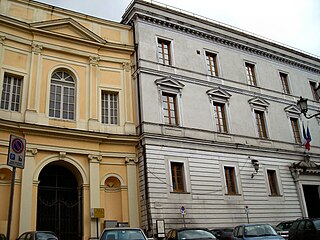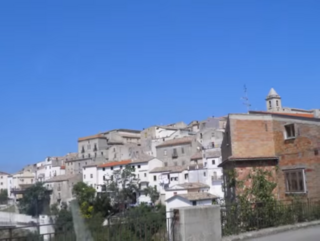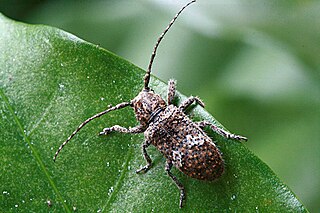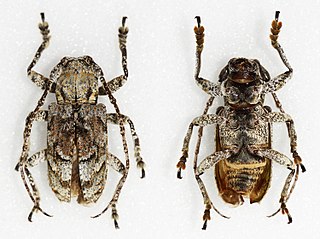Torella del Sannio is a town and comune in the province of Campobasso.

The University of Sannio is a university located in Benevento, southern Italy. Founded in 1998, the University of Sannio is organized in 4 faculties with almost 6,000 students and offers courses at undergraduate and postgraduate level in the fields of Law, Statistics, the Environment, Geology, Biology, Biotechnology, Civil Engineering, Computer Engineering, Energy Engineering, Electronic Engineering, Economics and Business Organization.
Cantalupo nel Sannio is a town and comune in the province of Isernia, in the Molise region of southern Italy.

Cerreto Sannita is a comune (municipality) in the Province of Benevento in the Italian region Campania, located about 60 km northeast of Naples and about 25 km northwest of Benevento.
San Giorgio del Sannio is a comune (municipality) in the Province of Benevento in the Italian region Campania, located about 60 km northeast of Naples and about 9 km southeast of Benevento. As of 31 December 2004, it had a population of 9,785 and an area of 22.3 km2.
San Leucio del Sannio is a comune (municipality) in the Province of Benevento in the Italian region Campania, located about 50 km northeast of Naples and about 6 km south of Benevento. As of 31 December 2004, it had a population of 3,269 and an area of 10.0 km2.
Santa Croce del Sannio is a comune (municipality) in the Province of Benevento in the Italian region Campania, located about 70 km northeast of Naples and about 30 km north of Benevento.
Duronia is a comune (municipality) in the Province of Campobasso in the Italian region Molise, located about 20 kilometres (12 mi) northwest of Campobasso. As of 31 December 2004, it had a population of 473 and an area of 22.2 square kilometres (8.6 sq mi).

Montefalcone nel Sannio is a comune (municipality) in the Province of Campobasso in the Italian region Molise, located about 35 kilometres (22 mi) north of Campobasso.
Morrone del Sannio is a comune (municipality) in the Province of Campobasso in the Italian region Molise, located about 20 kilometres (12 mi) northeast of Campobasso.
San Giuliano del Sannio is a comune (municipality) in the Province of Campobasso in the Italian region Molise, located about 13 kilometres (8 mi) south of Campobasso.
Belmonte del Sannio is a comune (municipality) in the Province of Isernia in the Italian region Molise, located about 35 kilometres (22 mi) northwest of Campobasso and about 30 kilometres (19 mi) northeast of Isernia.

Civitanova del Sannio is a comune (municipality) in the Province of Isernia in the Italian region Molise, located about 25 kilometres (16 mi) northwest of Campobasso and about 15 kilometres (9 mi) northeast of Isernia.

Diacrisia sannio, the clouded buff, is a moth of the family Erebidae. The species was first described by Carl Linnaeus in his 1758 10th edition of Systema Naturae. It is found in the Palearctic realm from Ireland to Siberia. It is not found in North Africa. In the Russian Far East, eastern China, Korea, and Japan it is replaced by Diacrisia irene.
Barbera del Sannio is a red Italian wine grape variety that is grown in the Campania region of southern Italy. Despite the similarities in name and appearance, the grape has no close genetic relationship with the Piedmont wine grapes Barbera or Barbera bianca or the Sardinian wine grape Barbera Sarda and is, instead, more closely related to the Campanian varieties Casavecchia and Catalanesca and the Apulian grape Nero di Troia.

Rhytiphora is a genus of flat-faced longhorn beetles in the Pteropliini tribe of the subfamily Lamiinae. The genus was first described in 1835 by Jean Guillaume Audinet-Serville.

Rhytiphora bankii is a species of beetle in the family Cerambycidae. It was first described by Johan Christian Fabricius in 1775, under the genus Lamia. It is known from Australia, the Philippines, Borneo, Java, Micronesia, New Guinea, Hawaii, Moluccas, Sumatra, Vietnam, and has been introduced into Japan. The Australian species of Prosoplus were synonymised with Rhytiphora in 2013.

Rhytiphora maculicornis is a species of beetle in the family Cerambycidae. It was described by Francis Polkinghorne Pascoe in 1858. It is from Australia.
Rhytiphora saundersi is a species of beetle in the family Cerambycidae. It was described by Francis Polkinghorne Pascoe in 1857. It is known from Australia. It contains the varietas Rhytiphora saundersi var. spenceri.
The Benevento dialect is a vernacular variety from the Campanian dialect that has undergone an evolution in a restricted space, roughly corresponding to the territory of the pontifical exclave of Benevento; this vernacular is placed side by side with other similar linguistic types referable to the same lineage and, in terms of phonetics, morphology and lexicon, it differs in some respects from Neapolitan.







